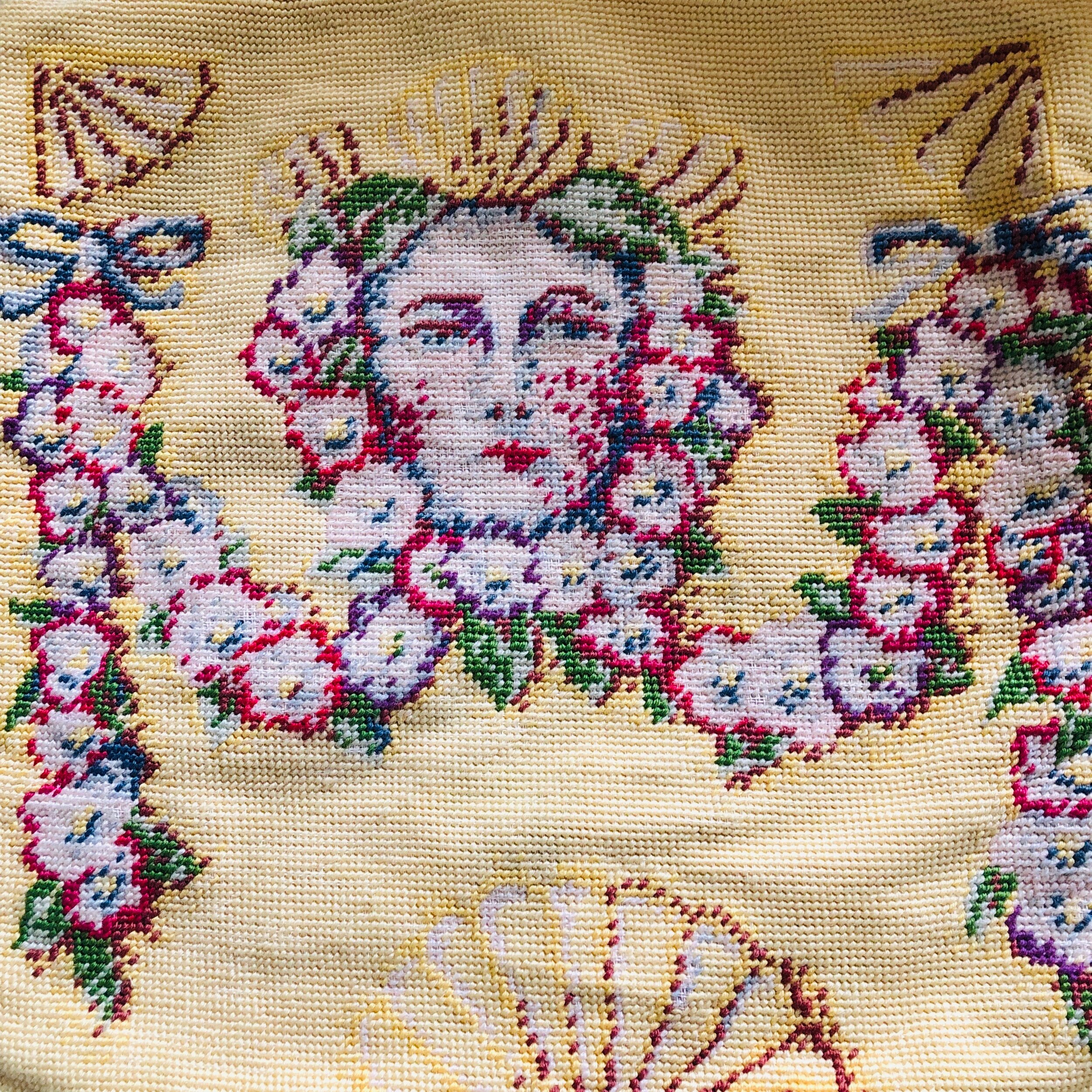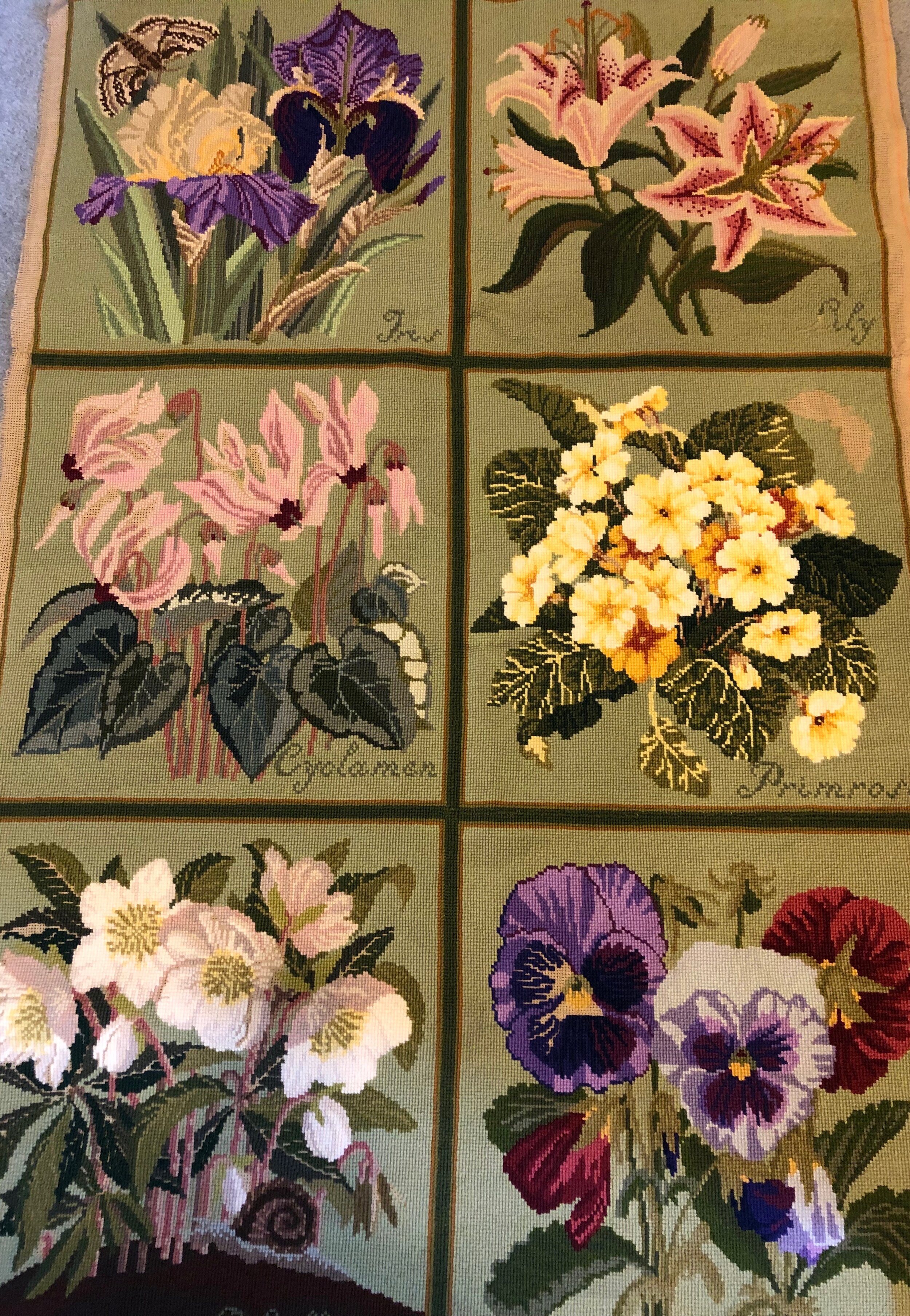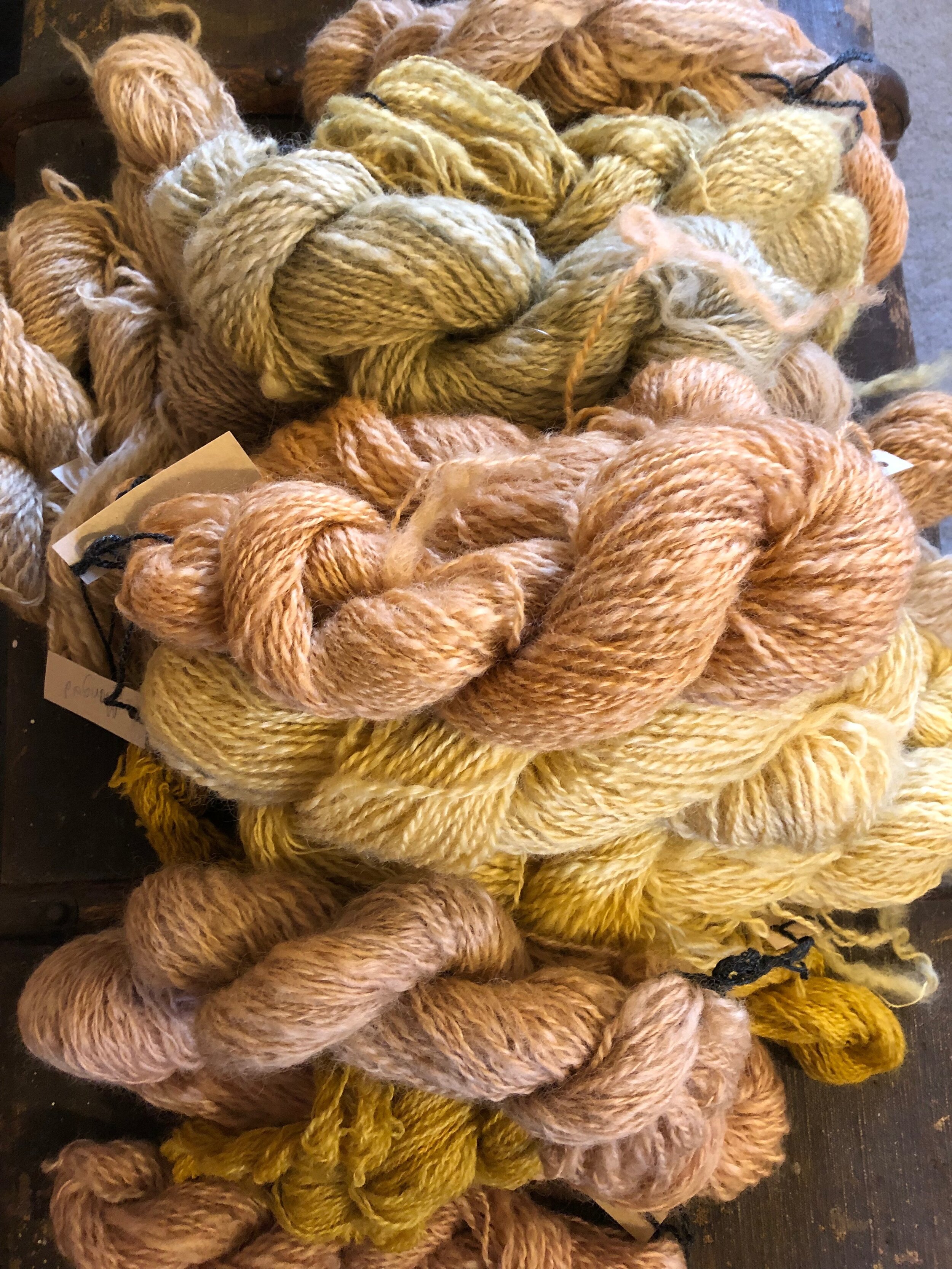Sally Graham and her daughter, Frances Paki, live close enough for regular quality time together - including knitting, of course! Sally wears her Orkney Cardigan by Marie Wallin, while Frances is sporting the Whitehorse jumper by Caitlin Hunter and a pair of self-drafted trousers.
Auckland’s Frances Paki and her mum, Sally Graham, are two exceedingly inspirational makers. Knitting, sewing, gardening and cooking are all part of their lives - daily habits of creativity and care for themselves and their families. Frances, 34, grew up rural, just south of Auckland and now lives closer to Auckland central with her family, where she works from home doing pattern making and sewing. Her mum, Sally, is 60 and works part-time as a paediatric nurse. Although she grew up on the South Island, she’s lived in and around Auckland most of her adult life, which keeps her close to family (and her darling wee granddaughter). “Part-time is great,” Sally said, “as I have time for knitting, spinning and sewing. I also love gardening and have a small city garden which is crammed full of plants. My next project is to try and get more of a dye garden established.”
We were fortunate enough to get them to sit still long enough to answer some questions for us about their lives, how they incorporate daily creativity into their worlds, and the value they place on making. We’ll start with Frances.
Newtown House: Please tell us how you got started in the fibre arts - did you learn as children, who taught you, and what encouraged you to keep going?
A selection of Frances’ earliest creations - including a hat she made for Brownies.
Frances Paki: Mum taught me many crafts as a kid. Knitting, sewing, crochet, cross-stitch, tapestry, cooking, gardening - she was always making things for herself, me and my brother, and the home. There were always materials around so it was easy to keep going, and mum was always supportive of projects. I went to manual during form 1 and 2 where I sewed, cooked and did woodwork. I remember finding the sewing and cooking we learnt being relatively straightforward because I did it a lot at home already. Woodwork was fun, and one term I made a huge chair with storage under the seat. I have sewn throughout most of my life but stopped knitting during my mid-late teens and picked it up again in my twenties. I was traveling all the time for work and wanted something to satisfy my making needs while I was away. Now I like to make things for my own family. It is a part of my everyday life.
NH: Tell us about some of your earliest sewing / knitting / crafting memories...and do you still have any of the garments or other treasures you might've made?
FP: I vividly remember knitting a hat for Brownies when I was 8 or 9. It is an apricot colour. I remember Mum helped with a few rows, as did her sister, Jane, when she came stay while I was making it. I have memories of making many pouches/bags on the sewing machine and a doing a ballet slipper cross-stitch that I was very proud of. I am quite sentimental when it comes to handmade things. I still have the hat and the cross-stitch and a few other treasures made when I was young.
NH: Why is it important to you to make things for yourselves and your loved ones? Has this become more important over time? If so, why?
FP: There's something very satisfying about wearing something you've made, or seeing someone you love wear something you've made. I think I've always appreciated handmade things but there was a time when I enjoyed shopping more. Making is definitely growing in importance for me as I get older and my family has grown. It's also important for me to make so our daughters learn that it is possible to do so many things yourself and you don't need to always buy it from a shop.
NH: Following on from that, what aspects of your crafts give you the most joy?
FP: I really enjoy the planning aspect of making. Finding the right pattern for a lovely piece of fabric, looking through my wardrobe and figuring out what I need for the coming season. Knitting has grown in importance for me since I started sewing for a job. I still enjoy sewing but needed something different for my down time and knitting does that. I find it very relaxing and rarely a day goes past when I don't knit.
Frances dyed the rusty colour of Moeke yarn herself, using madder root, to complete this Grandma Shawl by Junko Okamoto.
NH: Tell us about your favourite patterns or styles - and how your choices may have evolved over time.
FP: The rise of Independent pattern makers is amazing. I remember spending a lot of time in the local fabric shop looking at “Big 4” sewing patterns and that was all I would sew. Now I very rarely sew from them. I also went through a vintage pattern phase. I would find lots of lovely patterns while I was traveling and couldn't help but buy them. I learnt to pattern draft about 15 years ago and since then I have drafted a lot of my own patterns. Some of my favourite pattern designers are Merchant and Mills, Pattern Fantastique and Grainline Studio. I have definitely started sewing more 'basics' - T-shirts, jeans, jackets - in recent years, as opposed to multiple fancy dresses. I think is a reflection of my life changing, both work and personal.
NH: There was a time that skills like sewing, and knitting, and crochet, and cooking, were called "the domestic arts", were taught in schools and were mostly practiced by women in the home. These days such courses are rarely taught in school, and "the domestic arts" can sometimes be seen as less important than other pursuits. I'm guessing you'd reject this trend, and I'd love to hear your thoughts on this!
FP: It's hard to get a good gauge on this because so many people, mostly women, throughout my life have practiced 'the domestic arts'. It has always been a normal thing to do, and often a part of everyday life. In my life it is almost those who don't make that are in the minority. I have an amazing group of friends who knit, sew, spin, dye. I taught my now 14-year-old step-daughter to sew and knit a few years ago. She still dabbles occasionally, though she enjoys cooking and drawing more. My two-year-old likes to sit in my lap and we knit together with my hands on hers. I will definitely encourage her interest. I think they are important skills to learn - clothing and food are a part of our every day, so it makes sense that we know how to make it it for ourselves.
Next, it’s Sally’s turn!
NH: Please tell us how you got started in the fibre arts - did you learn as children, who taught you, and what encouraged you to keep going?
Sally Graham: I learnt to knit as quite a young child. I am the eldest of four siblings (two sisters and a brother) - we are all close in age and spent our youngest years on a farm on the South Island. Somehow my mother found time to sew and knit nearly all our clothes - often including matching clothes for our dolls. (All of the dolls’ clothes I still have.) Maybe she taught us to knit and sew at a young age so we could make our own! I do recall making a few clothes for myself clothes at primary school - I think they probably quite roughly made but I did wear them out places.
Sally knit this vest from natural dyed yarn she spun and dyed while on a course at Nelson Polytech 40 years ago.
In the 1960s and ‘70s girls still did sewing and cooking at 'manual' and even though I attended a tiny country school, we went to the 'big smoke' Reefton once a month in the school bus for this, which was great fun (apart from the ghastly windy roads which made me feel carsick)! As a teenager I made many of my own clothes, mainly long dresses and skirts - supplemented by op shop buys. Unbleached calico was my fabric of choice, which I then dyed. In about 1979 i spent a year at Nelson Polytech doing a weaving and spinning course. It was fantastic and I learnt so much. I made so many things, most of which I gave away. Sadly I have not done any weaving since, mainly as I haven't had a loom, however this is something I am keen to try again hopefully soon. I am still spinning - after a lull for several years - and am now enjoying re-discovering natural dyes. [photos]
NH: Tell us about some of your earliest sewing / knitting / crafting memories...and do you still have any of the garments or other treasures you might've made?
SG: I have quite a few knitted garments from my teenage years - nothing earlier. The vest in the photo was made using the wool I spun and dyed whilst doing the spinning course in Nelson.
NH: Why is it important to you to make things for yourselves and your loved ones? Has this become more important over time? If so, why?
SG: As a young mother in the 1980s I automatically sewed and knitted most of my children's clothes - cheap imported clothes were still not widely available and just about everyone I knew made their own. I also made many of my own and my husband’s clothes at this time. It is now so lovely to have some of these garments still around and my granddaughter able to wear them. Because Frances is such an accomplished sewer and knitter, I have not made much for Tiraki. I like to try and knit a little garment to give friends and colleagues at work for their new babies.
NH: Following on from that, what aspects of your crafts give you the most joy?
SG: I love the anticipation of planning and starting a new project and then when it is completed if it works out how I was hoping it would it is really gratifying. (It's not always the case - and I've had many completed projects that have not just not been right.) I do enjoy knitting for other people although there is always a niggling worry that it won’t be quite 'right’.
NH: Tell us about your favourite patterns or styles - and how your choices may have evolved over time.
SG: As my children grew up, I made less clothing for them. I became quite obsessed with needlework - particularly cross-stitch and tapestry - and produced cushion covers. (My favourite one is shown in the photo looking very tatty.) I also produced lots of pictures for the wall - many as gifts. I started an Elizabeth Bradley rug over 20 years ago and have nearly completed it, however I have done nothing to it for over 10 years!! [Photo included]
A few of Sally’s recent knits, including Kate Davies’ Paper Dolls, Petiteknit’s Balloon Sweater, Marie Wallin’s Orkney cardigan and the Aileas cardigan by Isabell Kraemer.
When Frances started getting into knitting she introduced me to the world of Ravelry and all the wonderful independent knitting pattern makers and yarn dyers. Previously one went to the local wool shop and 'put aside' an approximate amount of wool, which was great as it meant you did not have to buy more than you needed - and more importantly didn't run out! Also I only used to buy wool for the project I was working on and did not have a 'stash' like I do now! Knitting on circular needles was rare - nowadays that is my go-to. However I knitted my fair isle Marie Wallin cardigan on long needles in the traditional way doing back, fronts and sleeves, and it was nice. There seem to be so many techniques for casting on and off, shaping etc that I never knew of previously - it's a lot to learn, thank goodness for YouTube. I love knitting with a lot of detail - I get bored with rows and rows of stocking stitch. I think my favourite is fair isle. I would love to go to the Shetland Islands some day.
NH: There was a time that skills like sewing, and knitting, and crochet, and cooking, were called "the domestic arts", were taught in schools and were mostly practiced by women in the home. These days such courses are rarely taught in school, and "the domestic arts" can sometimes be seen as less important than other pursuits. I'm guessing you'd reject this trend, and I'd love to hear your thoughts on this!
SG: Like I said at the start I did sewing and cooking at school once a month in form 1 and 2. It was girls only then, and I think boys should definitely have the opportunity to learn these skills - it should be compulsory - especially learning to cook as I get that sewing is not for everyone. I love seeing so many young women (and some men) taking up knitting and sewing. I am so happy that Frances has developed such a passion for knitting and sewing and she now helps me when I can't figure something out! I am very proud of her, she has a lovely group of friends who get together regularly for knit nights. I think that fibre arts are definitely alive and well.
The gallery below shows a selection of Sally and Frances’ creations, including Frances’ beautiful Tamarack jacket with hand quilting and Sally’s stunning needlepoint.










